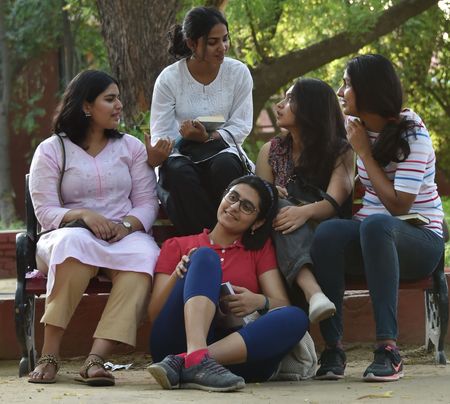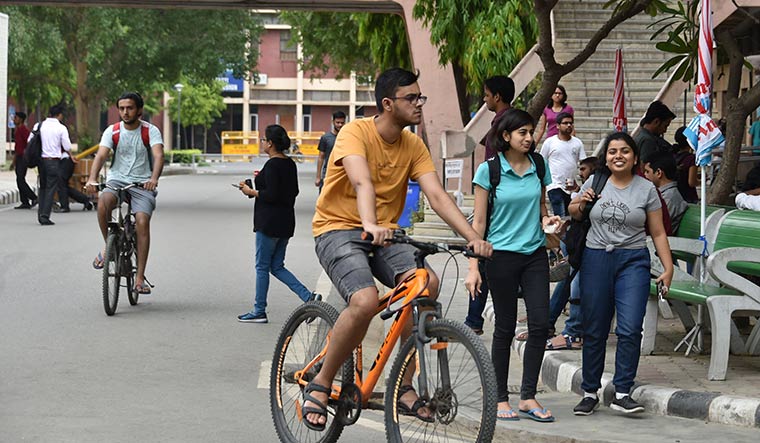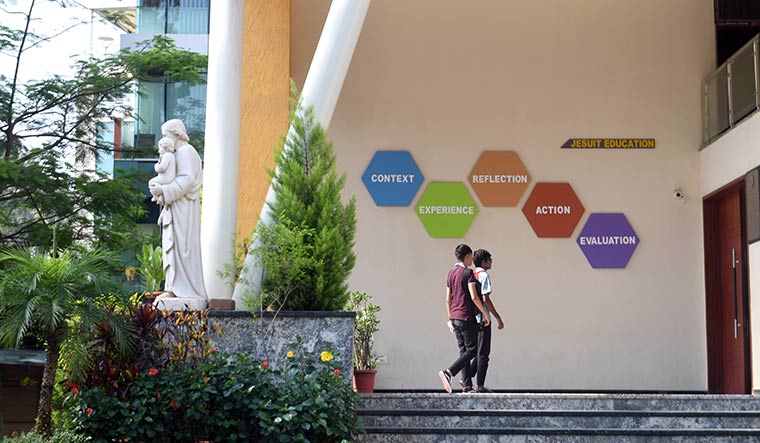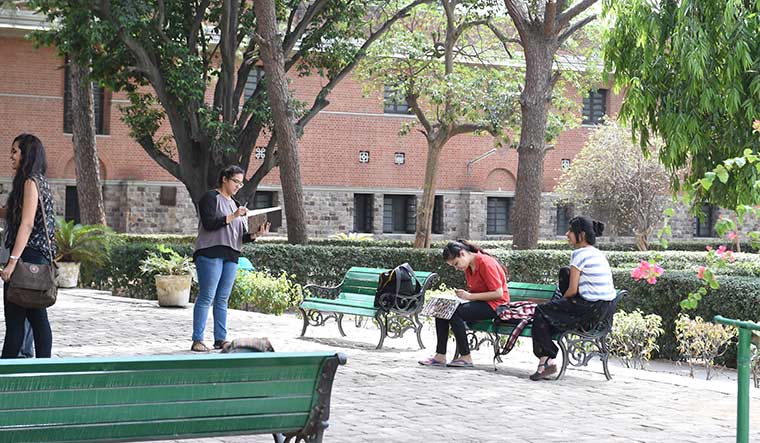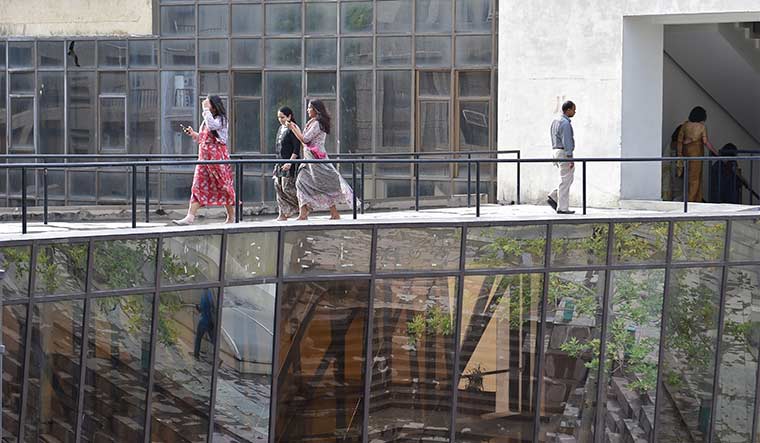When Professor Suman Sharma, principal of Lady Shri Ram College for Women, New Delhi, went to Coimbatore last year, Dr Nalla G. Palaniswami, the chairman of a number of colleges there, sought her out for a small conversation. He said he had been extremely concerned and worried about two girls from his village, because they were going to Delhi, and to an institution as prestigious as LSR at that. His worry had been misplaced, Dr Palaniswami told her. When he met the girls six months later their body language had changed and they were oozing confidence. “How did you do that?” the senior doctor-turned-educationist asked Sharma.
Sharma, who remembered the two and their story well gave the entire credit for mentoring them to the students of the college, particularly the seniors. For, the two girls had not only moved from a tiny village to the national capital, but had joined LSR without being fluent in English or Hindi. “Seventy per cent of our students come from remote parts of the country,” says Sharma. “They come not just from small towns, but also rural backgrounds.”
St Stephen’s College, which has alumni that ooze urbane polish, also has students who do not quite fit the widely held perceptions about its students. Says principal Professor John Varghese, “We do have a number of students coming from non-metropolitan towns, and they are here on the basis of their hard work. What brings them to college is their knowledge of the subject, and their aspiration to do well.” It is like a great fire burning within, to do well for themselves, adds Varghese. However, they do face some trouble. They come to college and find that their language is not perfect, that they are unfamiliar with certain practices, which Varghese says is second nature for city kids. “But these children pick up, and they do it very quickly,” he says.
Gopika Bhardwaj, associate professor at the Post Graduate Government College for Girls, Sector 11, Chandigarh, says: “We have a good number of students from the countryside. Their parents are open to the idea of their daughters living far away, many as paying guests, too, and at considerable cost.” The difference between the students from rural areas and their urban counterparts, says Bhardwaj, is that the former take a year or two to figure out career options beyond the obvious. People from rural areas are very motivated and driven, says Professor V. Ramgopal Rao, director, IIT Delhi. “We see that all the time,” he says. “They have come through a very rigorous screening process. They all would have been toppers in their schools. But, here, everybody is a topper, competing with each other.” Inevitably, some are left behind. When this happens, says Rao, they develop an inferiority complex and sometimes it affects them. “But, that is where the faculty step in and hold counselling sessions so that they can pick up and compete with others,” says Rao. “And, almost all of them do.”
Reverend Daniel Fernandes, principal, St Joseph’s College of Commerce, Bengaluru, says that a lot of students from rural areas and small towns apply for admission at the college. “In fact, the college encourages such students with good academic record to apply,” says Fernandes. “The vision and mission of Jesuit education emphasises on reaching out to the marginalised in every way possible.”
Akihito Yepthomi arrived at Ansal University’s Vatel India School of Hospitality Management in Gurugram after working for a couple of years in his family’s bakery in Dimapur, Nagaland. His cousin could make a six-tier cake, and while he was himself fond of cooking, Akihito did not think the skill was enough to take him places. Today, he knows what his next step will be. “When I feel confident of managing the front office of a hotel, I will try to join an MBA programme,” he says.
No longer the ivory towers they once were, most colleges today have students coming from remote corners of the country, and yearning for quality higher education. And the campuses have rolled out the red carpet for aspirational young Indians. The transformative role that higher education is playing is stark and visible, particularly as the institutions are themselves transforming with the times—with the idea of fostering the entrepreneurial spirit in all of their students.
Says Rao: “We did a survey of all the BTech students here. Every second student, if not every student, wants to become an entrepreneur within the next 10 years.” The survey also showed that only one in five students knew what to do (what problem to work on) and how to become an entrepreneur. This finding led the country’s premier technology institute to start a new programme this year—a minor degree in entrepreneurship at the department of management studies. Now, any student of IIT Delhi can take six courses in entrepreneurship, and do internships so that they can be introduced to how startups are run, and find the problems they will solve.
IIT Delhi has a Students Start-up Action Plan, which allows students to present their ideas to a committee. The institute funds and nurtures that idea, with mentorship from the faculty and converts it into a startup. Rao says they have hundreds of startups.
The story of how the incubation centre at St Stephen’s came into being is truly intriguing. Three years ago, the principal and four professors were interviewing students for admission. Bhanu Prakash Jonnalagadda, an applicant from Hyderabad, had mentioned in his application that he was an entrepreneur. He was asked to explain that. “We were dumbstruck,” says Varghese. “He had set up a chain of small ice cream shops in Hyderabad. After two years, he sold the chain for Rs1.2 crore—this was a little lad, just out of school. He impressed all of us. He joined mathematics.” The principal kept track of the boy’s progress and he was faring well. One night, Varghese, during his routine round of the campus, found Jonnalagadda walking towards his room at around 8pm. Asked where he had gone at that hour, he replied that he was returning from the city, where he had set up a business!
Varghese called him to his office the next day and asked if he could do something for the college. And thus was born The Incubation Centre (TIC) at St Stephen’s. Jonnalagadda and a couple of others put together a little society where they incubate ideas, encourage others on how to go about selling their ideas, getting funding, and give the venture a structure. Now, people who see merit in the students’ ideas and want to support their initiative can do so through TIC. One of the other founders of TIC was Harshidh, whose own entrepreneurial skill came to light when he applied for permission to travel. Harshidh had entered and won a global competition. The project was to support Malaysia in its efforts to stop people smoking in public spaces. The two founders have just graduated, but TIC continues to be a roaring success. Many companies have shown interest in what these students are offering. It hardly matters that St Stephen’s is largely a humanities college.
This goes to prove that the arts and science colleges are not lagging behind in making entrepreneurs of their students. “The Give Life Bakery is a very good example for fostering entrepreneurship, wherein students run the bakery in the college,” says Reverend F. Andrew, principal of Loyola College, Chennai. The college has an entrepreneurship cell and it has registered a company to encourage startups. Sharma, principal of LSR, says: “Ours is one of a kind—the institutional innovation council under the ministry of human resource development—given it is not a technical college.” The idea of the government’s IICs is to create a vibrant local innovation ecosystem, provide startup supporting mechanisms in higher educational institutions, prepare the institute for Atal Ranking of Institutions on Innovation Achievements Framework, scout for ideas and pre-incubation ideas and develop cognitive ability for students.
LSR fosters entrepreneurship through “several beyond-the-classroom endeavours” through the entrepreneurship cell. By helping empower women, children and the marginalised across the country through short and not-so-short field trips, the students are sensitised, exposed to real life problems, and many alumni have turned entrepreneurs. “They often come to the college, inspire our students, and even help them along,” says Sharma. And the connect between the students and the nearby Zamrudpur village is 24x7.
At Ansal University, students and faculty present their ideas before a panel headed by the dean (research, innovation and development). They discuss it, decide whether it is worth commercialising, and, if so, whether to file a patent or simply implement it. “We give them the seed money [050,000 to 01 lakh] to support the idea. Some students bring their own funds. Then, we apply for funding from different agencies, including the department of science and technology,” says Professor Raj Singh, vice-chancellor of Ansal University. “Every year, we have been able to produce three or four entrepreneurs this way.”
A red and cream car driven by solar energy is running on the campus. Now a group of students is working to make it go driverless, using robotics, artificial intelligence and machine learning. It is, as the vice-chancellor says, a work in progress for now.
The stories and the scale may differ from college to college, but the underlying idea is similar. The business incubator at Manav Rachna International Institute of Research and Studies has so far resulted in three startups being run by students, and 10 others are “working on their dreams” as Professor Sanjay Srivastava, the vice-chancellor, puts it. LNMIIT, Jaipur, offers various services to budding entrepreneurs. Director Rahul Banerjee says this includes help in accessing services of chartered accountants, tax consultants and patent lawyers.
At Lloyd Group of Institutions, Greater Noida, the management is the angel investor in many student projects, according to group director Professor Vandana Arora Sethi. “We shall soon see the results hitting the market,” she says. Sarada Muraleedharan, director general of the National Institute of Fashion Technology, says that a large number of students have become successful entrepreneurs taking advantage of the entrepreneurship content in the NIFT curriculum. NIFT has initiated the setting up of a design innovation incubator at three campuses (New Delhi, Bengaluru and Mumbai) to drive innovation in areas such as athleisure and smart wearable systems. Shobhit University, Meerut, focuses on cross-functional training to help develop entrepreneurs. For example, students of biomedical engineering are exposed to sales and services, too. Chancellor Kunwar Shekhar Vijendra says that the students have to spend time at some industry in the last semester.
In fact, corporates are both giving a big push to this fostering of entrepreneurship among students and benefitting by it. And the relationship between students and industry has become symbiotic lately. Rao, director of IIT Delhi, says they started organising industry days on campus to connect with the industry, understand their problems and see if the institute’s research could solve some of their problems. “If our students and faculty have a technology to solve a problem, can they as a team start a company and deliver their solution to society? So we started to work more on the delivery aspect of it,” says Rao. “RandD was always research and development. For us it is relevance and delivery as well.”
About 300 industries come to the campus on industry day. The PhD students demonstrate their work and faculty members give thematic talks on research being done. If an industry is interested in working in a particular area, they can start Centres of Excellence, fund these and leave their problems there so that solutions could be found. Industries can also engage a faculty member for doing sponsored research, or fund a faculty member and provide resources to find solutions to a problem in a year or two. If the problem is short term, they can engage the faculty member as consultant.
“We have created eight Centres of Excellence in the last two years,” says Rao, adding that 50 per cent of the faculty will have been involved in some kind of a consultancy in the project. And to top it all, 90 per cent of the faculty would have done some sponsored research project in the last five years. “Because, without being active in doing research you cannot even survive in our system any more, there is so much of emphasis on research,” he points out.
Professor Souvik Bhattacharyya, vice-chancellor of BITS Pilani, says that industry engagement is one of the cornerstones of the institute’s educational philosophy. There is a sustained and immersive industry experience for the student, structured in two stages. The first is an eight-week exposure at the end of two years, and the second a twenty-two-week engagement in a live assignment, both organised on the industry premises, with the guidance and mentoring of experts from the industry, and under the supervision and instruction provided by faculty members.
“The model has ensured value for all stakeholders, the students, the industry, and the institute,” he says, elaborating that for the industry, the programme offers a continuous stream of well-educated and skilled manpower leading to increased productivity, an opportunity for branding and to attract potential recruits, and access to expertise from academia. The students get an opportunity to do engineering, for career planning, for overall personality development, and an aid to a smooth transition to the profession. Also, the involvement from the industry is at the level of founders, co-founders, and CEOs who themselves come and take classes. According to Bhattacharyya, a spin-off benefit is a significant number of pre-placement offers of employment.
BITS as an institute, too, gains. For the programme offers the means for its faculty members to engage with industry, obtain valuable feedback on its educational programmes, and potentially build partnerships. “Industry has to and is becoming a partner in higher education,” says Vice Chancellor Raj Singh of Ansal University, which has over 250 industrial partners. “Given the kind of training facilities required in higher education today, institutions may not be in a position to afford them. It is intensive investment. That is where partnership with industry is gaining importance.”
One of the collaborators, Oxsight, a company promoted by Oxford University, has developed a smart glass that is meant for near blind people (5 to 10 per cent vision). If they use these glasses, they can lead a normal life. Oxsight set up a Centre of Excellence in the Sushant School of Health Sciences, Ansal University, eight months ago. One of the programmes is a four-year degree course in optometery.
“The awareness of optometry is very low, and hospitals informally train themselves. The world over it a four-year programme,” says Professor Monica Chaudhry, director of the School of Health Sciences. She herself did the four-year course at AIIMS, which along with the PGI, Chandigarh, has ten seats each. There are 40 millions jobs in this profession now, according to her. More importantly, when the government introduces the Allied Health Bill in Parliament over the next few months, a four-year degree will become mandatory for optometrists. Menicon Worldwide, the contact lens makers, and Lucideus Technologies, which works in the area of cybersecurity, have also set up Centres of Excellence on campus.
The opportunities are possibly there, as are the jobs, waiting to be identified and lapped up. But how do budding entrepreneurs identify the problems to solve? That is where immersion in the community has become an integral part of higher education. Almost every good college today is sharply focused in this immersion, which is no longer a fun-filled field trip.
IIT Delhi’s discovery of the path to the community is like a moving socio-economic story. “At some point of time we had lost touch with society,” says Rao. “So we became islands of excellence.” So, in the last five years in IIT Delhi, the effort was to reorient research to what makes a difference to society. The institute did everything from participating in government schemes to students and faculty being in the fields to find solutions to stubble burning in Punjab and Haryana. Sharma has no doubt that her students at LSR find problems in areas they are sensitive to, while out on a two or three-week field trip, and there begins a long-term problem-solving exercise. Rev. Fernandes says that experiential learning techniques such as internships, planned field visits, and social and industrial visits gain importance as they ensure that students strike the right balance between employability and knowledge acquisition.
So, how does this community outreach help students? A group of students from Ansal University went to study the adverse gender ratio in some villages of Haryana. But they saw something else also. In the last panchayat elections in Haryana, the government prescribed certain minimum qualifications for the panches and sarpanches. There was a lot of resistance, the matter went to the court, which upheld the decision of the government. There were certain families that had held headship of the village for generations. But now there was no qualified woman in the family for the constituency reserved for women! Women were murdered and the sons were married again. In certain communities, where polygamy is permitted, the sons were married again to an “eligible” daughter-in-law.
“A purely political issue turned into a serious social issue,” says Raj Singh. “No matter what I do, I cannot teach this to a student in a classroom. They have to learn this from the field. We gave them a project on how to revive a tourist complex, and to submit the report to the government. Students of different disciplines worked together and each one applied his or her discipline. They saw the connection.” He terms the outcome amazing. “We could successfully expand the learning opportunities of our students,” he says. “It exposed them to real life, showed them issues, increased their employability. It reflected in more permanent learning, their attendance, results... everything improved.”
Life and livelihood, at the end of the day, are knowing the problem that has to be solved using the knowledge gained. And colleges have now figured out that community opens students’ eyes. And, minds, too.
—With Mini P. Thomas.


